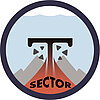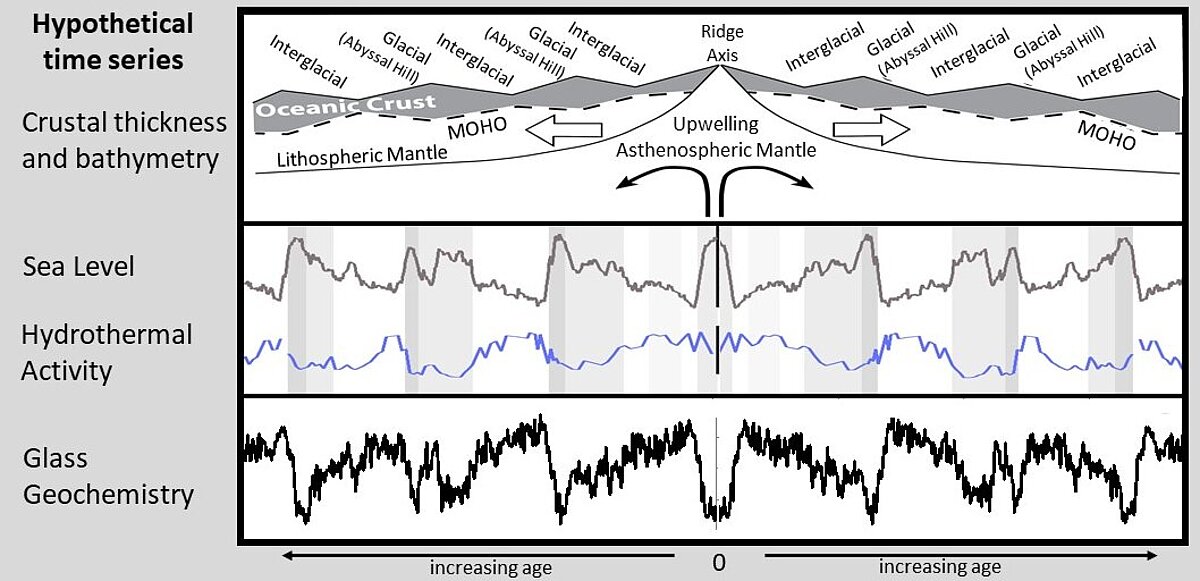T-SECTOR: Testing Solid Earth Climate connections Through mid Ocean Ridge time series
Project Summary
A key challenge in understanding the Earth system is quantifying the feedback between climate and the solid Earth, which requires long-term studies. One critical time series is the climate (sea level) record, showing transitions between ice ages and warm periods over millions of years, involving significant mass shifts between continents (ice) and oceans. Volcanic activity is sensitive to these pressure changes, but its response to glacial cycles is largely unknown for the global mid-ocean ridge system (MOR), where 80% of Earth's volcanism occurs.
Models suggest that sea level fluctuations affect crustal thickness, lava chemistry, and hydrothermal activity at MORs. However, creating high-resolution time series has been difficult because sediments quickly cover the sea floor as it moves away from the ridge, making direct sampling a challenge. Recent studies show that MOR eruptions leave glass samples on nearby sediments that can be preserved for up to 105,000 years. These carbonate-rich sediments can be precisely dated using oxygen isotope stratigraphy, offering a record of ridge eruptions (glasses) and hydrothermal activity (trace metals), which can be sampled by gravity coring.
Through closely spaced cores collected during multiple research cruises, we aim to create a high-resolution time series of volcanic and hydrothermal activity directly linked to climate records. Additionally, seismic techniques can track changes in crustal thickness over time. We propose to gather integrated data from slow, intermediate, and fast-spreading ridge segments over the past 1.5 million years in unprecedented detail. These results will allow us to test the influence of glacial cycles on MOR processes and provide the first high-resolution time series of ocean ridge magmatism, opening a new frontier in scientific exploration.
Hypothesis: Volcanism at mid ocean ridges oscillates inversely with sea level
During glacial periods, lower sea level (due to storage of seawater in glaciers on land) results in less hydrostatic pressure on the ridges, thus there is enhanced decompression melting creating thicker oceanic crust and more volcanism and hydrothermal activity. During interglacials, sea level is higher and we have the opposite effect.
Testing the hypotheisis requires innovative integrated time-series. This is now possible, but has never been accomplished previously. Pilot studies and models show melt & carbon flux and crustal thickness can vary up to 15% and hydrothermal activity by a factor of four (see references below).
The novelty of T-SECTOR:
• First high-resolution and integrated time series of lava (crustal) volume, chemistry and hydrothermal activity, opening up an entirely new dimension of mid-ocean ridge studies
• Definitive tests and development of the relationships between climate and the solid Earth
• New understanding of MOR processes (e.g. implications for ore forming processes and upper mantle heterogeneity)
Future Perspectives
T-SECTOR aims to literally open a new time dimension to ocean ridge studies, and to provide definite tests of the hypothesis, backed by theory, that sea level change influences ridge volcanism. Using data on the composition MORBs obtained from sediment hosted glasses, we aim to obtain time-series at an unprecedented resolution of 5-10ka over ≥1.5Ma, uniquely combined with records of hydrothermal activity in the same sediments and with data on crustal thickness and seafloor morphology. The project also proposes a novel approach to construct time series of MORB composition through seabed drilling, which will enable investigation of crustal production and other magmatic (volcanic and plutonic) processes at an unprecedented level. Once established, these approaches can also be used to construct time series of other seafloor spreading systems. These time series have the potential to transform our understanding of seafloor spreading processes and the scale of heterogeneities in the underlying mantle. They will help us understand the feedback between glacial/interglacial climate and earth processes, providing new insights into enhanced magmatism during glacial cycles and the linked emission of CO2 into the atmosphere. We will test new approaches for determining oceanic crustal thickness at high-resolution on time scales of climatic variations without the necessity of 3-D seismic studies. Finally, the closely-spaced sediment and basalt drill core profiles taken by German and U.S ships along the ~1.5Ma profiles will be stored at the GEOMAR Helmholtz Center and U.S. repositories respectively and will be available for study by other scientists with different questions than those we plan to address, e.g. looking at variations in non-traditional isotope systems (e.g. Mg, Fe, Zn isotopes) both in MORBs and the hydrothermally influenced sediments.
References:
-
Huybers, P. and C. Langmuir, Feedback between deglaciation, volcanism, and atmospheric CO2. Earth and Planetary Science Letters, 2009. 286(3): p. 479-491.https://doi.org/10.1016/j.epsl.2009.07.014
-
Huybers, P. and C.H. Langmuir, Delayed CO2 emissions from mid-ocean ridge volcanism as a possible cause of late-Pleistocene glacial cycles. Earth and Planetary Science Letters, 2017. 457: p.238-249. doi.org/10.1016/j.epsl.2016.09.021
-
Lund, D.C. and P.D. Asimow, Does sea level influence mid-ocean ridge magmatism on Milankovitch timescales? Geochemistry, Geophysics, Geosystems, 2011. 12(12). doi.org/10.1029/2011GC003693
-
Crowley, J.W., et al., Glacial cycles drive variations in the production of oceanic crust. Science, 2015. 347(6227): p. 1237-1240. doi.org/10.1126/science.1261508
-
Burley, J.M.A. and R.F. Katz, Variations in mid-ocean ridge CO2 emissions driven by glacial cycles. Earth and Planetary Science Letters, 2015. 426: p. 246-258. doi.org/10.1016/j.epsl.2015.06.031
-
Cerpa, N.G., D.W. Rees Jones, and R.F. Katz, Consequences of glacial cycles for magmatism and carbon transport at mid-ocean ridges. Earth and Planetary Science Letters, 2019. 528: p. 115845.https://doi.org/10.1016/j.epsl.2019.115845
-
Lim, D., et al., Enhancement of volcanic eruption in mid-ocean ridge during the last deglaciation: New sedimentary evidence in the middle part of Central Indian Ridge. Marine Geology, 2021. 440: p.106574. doi.org/10.1016/j.margeo.2021.106574
-
Tolstoy, M., Mid-ocean ridge eruptions as a climate valve. Geophysical Research Letters, 2015. 42(5): p. 1346-1351. doi.org/10.1002/2014GL063015





